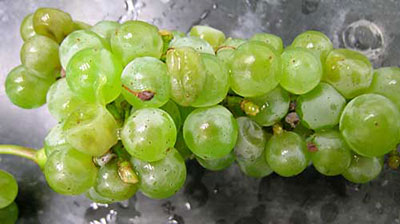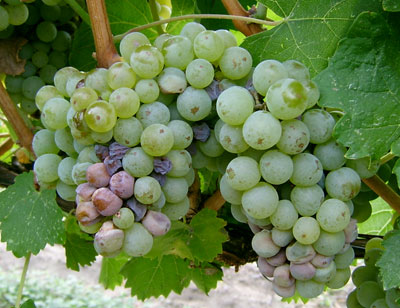Sour rot of grape
Sour rot is a cyclical problem in the Okanagan/Similkameen, reoccurring every couple of years and causing serious problems for vineyards. However, in the B.C. interior, the 2004 growing season is still considered to have experienced the greatest crop damage due to sour rot.
Varieties affected include Pinot Blanc, Pinot Gris, Riesling, Pinot Noir and Chardonnay. It is likely that sour rot has always been present, but it may have been confused with botrytis bunch rot in the past. Sour rot affects both crop yield and wine quality. Infected fruit can give an unpleasant flavour to the finished wine and push volatile acid beyond acceptable levels.
Symptoms
Symptoms include a soft watery rot with leakage of berry juice, and a distinctive vinegar smell. Large numbers of fruit flies, (also known as vinegar flies) and fruit fly larvae are generally present. The fruit flies produce ethyl acetate, a common fault in wine. There is very little tolerance of fruit contaminated with ethyl acetate. Sour rot appears similar to botrytis bunch rot. Affected berries are brick-coloured in white cultivars and purplish-brown in red cultivars.

Grapes infected with yeasts, causing sour rot. Photo courtesy Agriculture and Agri-Food Canada

Sour rot in 'Optima' grapes. Photo courtesy Agriculture and Agri-Food Canada
Disease cycle
Sour rot is caused by a number of undesirable yeasts and bacteria, but can occasionally be seen in association with other fungal rot diseases including Botrytis, Penicillium and Rhizopus. Causal agents of the 2004 Okanagan outbreak of sour rot included several bacterial species (Gluconobacter cerinus, G. albidus and G. frateurii) and at least three yeast species (Pichia kluyveri, Candida spp. and Hanseniaspora uvarum).
Sour rot pathogens gain entry into grape berries through cracks and wounds caused by wasps, hail, birds, powdery mildew, botrytis, or by berry splitting caused by excessive vigour in tight clusters. Injured fruit attracts fruit flies (vinegar flies) which also effectively carry and spread the disease-causing organisms. During favourable conditions (warm moist weather, sugar accumulation in berries) the fruit fly will lay hundreds of eggs and start a new generation every ten to twelve days. Under the right conditions this can lead to explosive disease outbreaks. Fruit left on the ground from post-veraison bunch thinning can also be a contributing factor to build-up of fruit fly populations.
Cultivars with tight clusters and thin skins are generally more susceptible to sour rot. Very vigorous vines seem to be more prone to the disease due to tighter bunches with berries more likely to burst, and also due to a higher moisture environment.
The onset of hot, dry weather can lead to the drying of the infected and damaged berries, thereby slowing the spread of the disease. Cool weather will considerably slow fruit fly population growth, in turn leading to a reduction in the spread of the disease.
Some local and Californian observations indicate that the use of botrytis fungicides during periods favourable to sour rot development may increase damage caused by sour rot. Some experts speculate that the fungicide may kill the micro-flora present on the berry surface. These organisms may have some protective effect against the yeasts and bacteria responsible for sour rot. However, research done in Italy in the early eighties found that powdery mildew and botrytis control, together with fruit fly control, significantly reduced the incidence of sour rot.
Prevention and control
- Reduce excessive vigour through the use of cover crops and/or the reduction of nitrogen fertilization and irrigation.
- Leaf removal between fruit set and veraison can lead to tougher berry skins, thereby reducing the risk of fruit injuries that attract fruit flies and allow pathogen entry.
- Control wasps through trapping and nest removal.
- Control powdery mildew to reduce grape berry lesions.
- Prevent bird damage.
- Thin bunches before or during veraison. Berries removed during late season thinning have higher sugars which can contribute to the fruit fly population increase.
- Discard affected bunches before or during harvest to minimize the negative effects on the wine.
- Insecticides are not recommended for control of common fruit flies on grape. Fruit flies quickly become resistant to most chemical control products due to their fast rate of multiplication. However, some insecticides are available for control of the fruit fly spotted wing drosophila. Check current recommendations for control products.
- The biofungicide Serenade Max is registered for suppression of sour rot.
- Some French sources recommend 2-3 applications of Bordeaux mixture (copper sulphate and hydrated lime) at ten to twelve day intervals around the time of veraison. Copper applied to the fruiting zone has the effect of thickening the grape berry skin, hence reducing the risk of lesions. See fungicide notes under powdery mildew for more information on copper fungicides.
